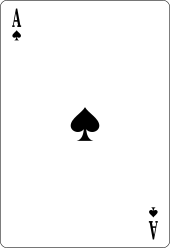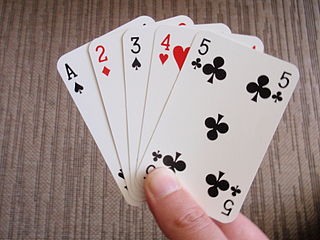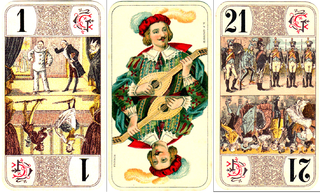

The ace of spades (also known as the Spadille and Death Card [1] ) is traditionally the highest and most valued card in the deck of playing cards. The actual value of the card varies from game to game. [2] [3]


The ace of spades (also known as the Spadille and Death Card [1] ) is traditionally the highest and most valued card in the deck of playing cards. The actual value of the card varies from game to game. [2] [3]
The ornate design of the ace of spades, common in packs today, stems from the 17th century, when James I and later Queen Anne imposed laws requiring the ace of spades to bear an insignia of the printing house. Stamp duty, an idea imported to England by Charles I, was extended to playing cards in 1711 by Queen Anne and lasted until 1960. [4] [5]
Over the years, a number of methods were used to show that duty had been paid. From 1712 onwards, one of the cards in the pack, usually the ace of spades, was marked with a hand stamp. In 1765 hand stamping was replaced by the printing of the official ace of spades by the Stamp Office, incorporating the royal coat of arms. In 1828 the Duty Ace of Spades (known as "Old Frizzle") was printed to indicate a reduced duty of a shilling had been paid. [6]
One maker of cards was caught in possession of forged aces and the equipment to produce them. This was a capital offence, the prosecutor the Attorney General Spencer Perceval (later to become the prime minister assassinated in 1812) obtained the conviction of Richard Harding and he was hanged in 1805. The association of the ace of spades with death may spring from such events. [7]
The system was changed again in 1862 when official threepenny duty wrappers were introduced and although the makers were free to use whatever design they wanted, most chose to keep the ornate ace of spades that is popular today. [6] The ace of spades is thus used to show the card manufacturer's information.
Since 1882, an annual pack of cards has been produced by the Worshipful Company of Makers of Playing Cards at the installation of each master and since 1888, a portrait of the Master has appeared at the centre of the ace of spades. [8]
The exact design of the ace card was so important, it eventually became the subject of design patents and trademarking. For example, on 5 December 1882, George G. White was granted U.S. design patent US0D0013473 [9] for his design. His ace design was adorned with male and female figures leaning onto the spade from either side.
This section may lend undue weight to certain ideas, incidents, or controversies. Please help to create a more balanced presentation. Discuss and resolve this issue before removing this message. (December 2022) |
The ace of spades has been employed on several occasions in the theatre of war. In the First World War, the 12th (Eastern) Division of the British Army used the Ace of spades symbol as their insignia. [10] In the Second World War, the 25th Infantry Division of the Indian Army used an Ace of Spades on a green background as their insignia. [11]
In World War II, the soldiers of the 506th Parachute Infantry Regiment of the American 101st Airborne Division were marked with the spades symbol painted on the sides of their helmets. In this capacity, it was used to represent good luck, due to its fortunate connotations in card playing. Following the confusion of a large-scale combat airborne operation, all four card-suits were used for ease of identification of regiments within the airborne division. Battalions within the regiments were denoted with tic marks or dots, struck from top clockwise: headquarters at the twelve o'clock position, 1st Battalion at the three o'clock, etc.
During the Vietnam War, the ace of spades was used as a tool of psychological warfare as it was common practice by US soldiers to leave the ace card on the bodies of killed Vietnamese. [12] They thought that the card's connections to French colonial rule of Vietnam and putative symbolism in Vietnamese tradition to mean death and ill-fortune would frighten and demoralise Viet Cong soldiers. [13] [14] [15] This custom was said to be so common that the United States Playing Card Company was asked by Charlie Company, 2nd Battalion, 35th Infantry Regiment to supply crates of that single card in bulk. The plain white tuck cases were marked "Bicycle Secret Weapon", and the cards were deliberately scattered in villages and in the jungle during raids. [16] [17] The ace of spades, while not a symbol of superstitious fear to the Viet Cong forces, did help the morale of American soldiers. Some U.S. soldiers and Marines were reportedly sticking this card in their helmet band as a sort of anti-peace sign. [18]
In 2003, a deck of most-wanted Iraqi playing cards was issued to U.S. soldiers during Operation Iraqi Freedom, with each card displaying the picture of a wanted Iraqi official on it. Saddam Hussein was placed on the "Ace of Spades" card.[ citation needed ]
The ace of spades is a symbol for people who are asexual and aromantic. People who are asexual, but not aromantic, use the ace of hearts as a symbol. [19]
Various idioms involving the ace of spades include "black as the ace of spades," which may refer either to completely black; totally without light or colour, colour, race, (lack of) morality, or (lack of) cleanliness in a person. [20] [lower-alpha 1] [21]
The French expression fagoté comme l'as de pique translates to "(badly) dressed like the ace of spades." [22]
The ace of spades is encoded into Unicode with the code point U+1F0A1, as part of the playing cards Unicode block. [23]
| Preview | 🂡 | |
|---|---|---|
| Unicode name | PLAYING CARD ACE OF SPADES | |
| Encodings | decimal | hex |
| Unicode | 127137 | U+1F0A1 |
| UTF-8 | 240 159 130 161 | F0 9F 82 A1 |
| UTF-16 | 55356 56481 | D83C DCA1 |
| Numeric character reference | 🂡 | 🂡 |

A playing card is a piece of specially prepared card stock, heavy paper, thin cardboard, plastic-coated paper, cotton-paper blend, or thin plastic that is marked with distinguishing motifs. Often the front (face) and back of each card has a finish to make handling easier. They are most commonly used for playing card games, and are also used in magic tricks, cardistry, card throwing, and card houses; cards may also be collected. Playing cards are typically palm-sized for convenient handling, and usually are sold together in a set as a deck of cards or pack of cards.

An ace is a playing card, die or domino with a single pip. In the standard French deck, an ace has a single suit symbol located in the middle of the card, sometimes large and decorated, especially in the case of the ace of spades. This embellishment on the ace of spades started when King James VI of Scotland and I of England required an insignia of the printing house to be printed on the ace of spades. This insignia was necessary for identifying the printing house and stamping it as having paid the new stamp tax. Although this requirement was abolished in 1960, the tradition has been kept by many card makers. In other countries the stamp and embellishments are usually found on ace cards; clubs in France, diamonds in Russia, and hearts in Genoa because they have the most blank space.

In playing cards, a suit is one of the categories into which the cards of a deck are divided. Most often, each card bears one of several pips (symbols) showing to which suit it belongs; the suit may alternatively or additionally be indicated by the color printed on the card. The rank for each card is determined by the number of pips on it, except on face cards. Ranking indicates which cards within a suit are better, higher or more valuable than others, whereas there is no order between the suits unless defined in the rules of a specific card game. In a single deck, there is exactly one card of any given rank in any given suit. A deck may include special cards that belong to no suit, often called jokers.

A sapper, also called a combat engineer, is a combatant or soldier who performs a variety of military engineering duties, such as breaching fortifications, demolitions, bridge-building, laying or clearing minefields, preparing field defenses, and road and airfield construction and repair.

The Worshipful Company of Makers of Playing Cards is one of the livery companies of the City of London, incorporated in 1628, and ranking at No.75 in the order of precedence. It is limited to 150 members, and its livery colours are red and white.

Bicycle Playing Cards is a brand of playing cards. Since 1885, the Bicycle brand has been manufactured by the United States Printing Company, which, in 1894, became the United States Playing Card Company (USPCC), now based in Erlanger, Kentucky. "Bicycle" is a trademark of that company.

The king is a playing card with a picture of a king displayed on it. The king is usually the highest-ranking face card. In the French version of playing cards and tarot decks, the king immediately outranks the queen. In Italian and Spanish playing cards, the king immediately outranks the knight. In German and Swiss playing cards, the king immediately outranks the Ober. In some games, the king is the highest-ranked card; in others, the Ace is higher. Aces began outranking kings around 1500 with Trappola being the earliest known game in which the aces were highest in all four suits. In the ace–ten family of games such as pinochle and Schnapsen, both the ace and the 10 rank higher than the king.

Ombre or l'Hombre is a fast-moving seventeenth-century trick-taking card game for three players and "the most successful card game ever invented."

The makeup of poker's dead man's hand has varied through the years. Currently, it is described as a two-pair poker hand consisting of the black aces and black eights. The pair of aces and eights, along with an unknown hole card, were reportedly held by Old West folk hero, lawman, and gunfighter Wild Bill Hickok when he was murdered while playing a game. No contemporaneous source, however, records the exact cards he held when killed. Author Frank Wilstach's 1926 book, Wild Bill Hickok: The Prince of Pistoleers, led to the popular modern held conception of the poker hand's contents.

The standard 52-card deck of French-suited playing cards is the most common pack of playing cards used today. In English-speaking countries it is the only traditional pack used for playing cards; in many countries of the world, however, it is used alongside other traditional, often older, standard packs with different suit systems such as those with German-, Italian-, Spanish- or Swiss suits. The most common pattern of French-suited cards worldwide and the only one commonly available in English-speaking countries is the English pattern pack. The second most common is the Belgian-Genoese pattern, designed in France, but whose use spread to Spain, Italy, the Ottoman Empire, the Balkans and much of North Africa and the Middle East. In addition to those, there are other major international and regional patterns including standard 52-card packs, for example, in Italy that use Italian-suited cards. In other regions, such as Spain and Switzerland, the traditional standard pack comprises 36, 40 or 48 cards.

Playing cards have been in Italy since the late 14th century. Until the mid 19th century, Italy was composed of many smaller independent states which led to the development of various regional patterns of playing cards; "Italian suited cards" normally only refer to cards originating from northeastern Italy around the former Republic of Venice, which are largely confined to northern Italy, parts of Switzerland, Dalmatia and southern Montenegro. Other parts of Italy traditionally use traditional local variants of Spanish suits, French suits or German suits.

Spades is one of the four playing card suits in the standard French-suited playing cards. It has the same shape as the leaf symbol in German-suited playing cards but its appearance is more akin to that of an upside down black heart with a stalk at its base. It symbolises the pike or halberd, two medieval weapons, but is actually an adaptation of the German suit symbol of Leaves created when French suits were invented around 1480.
Over the course of its history, the LGBT community has adopted certain symbols for self-identification to demonstrate unity, pride, shared values, and allegiance to one another. These symbols communicate ideas, concepts, and identity both within their communities and to mainstream culture. The two symbols most recognized internationally are the pink triangle and the rainbow flag.

The Bourgeois Tarot deck is a mid-19th century pattern of tarot cards of German origin that is used for playing card games in western Europe and Canada. It is not designed for divinatory purposes. This deck is most commonly found in France, Belgian Wallonia, Swiss Romandy and Canadian Québec for playing French Tarot; in southwest Germany for playing Cego and Dreierles; and in Denmark for Danish Tarok.

German Solo or just Solo is a German 8-card plain-trick game for 4 individual players using a 32-card, German- or French-suited Skat pack. It is essentially a simplification of Quadrille, itself a 4-player adaptation of Ombre. As in Quadrille, players bid for the privilege of declaring trumps and deciding whether to play alone or with a partner. Along with Ombre, Tarock and Schafkopf, German Solo influenced the development of Skat. Parlett calls it a "neat little descendant of Quadrille" and "a pleasant introduction" to the Ombre family of games.

The ace of hearts (A♥) is a card in a deck of playing cards: the ace in the suit of hearts (♥). There is one ace of hearts in a standard deck of 52 cards.

French-suited playing cards or French-suited cards are cards that use the French suits of trèfles, carreaux, cœurs, and piques. Each suit contains three or four face/court cards. In a standard 52-card deck these are the valet, the dame, and the roi (king). In addition, in Tarot packs, there is a cavalier (cavalier) ranking between the queen and the jack. Aside from these aspects, decks can include a wide variety of regional and national patterns, which often have different deck sizes. In comparison to Spanish, Italian, German, and Swiss playing cards, French cards are the most widespread due to the geopolitical, commercial, and cultural influence of France, the United Kingdom, and the United States in the 19th and 20th centuries. Other reasons for their popularity were the simplicity of the suit insignia, which simplifies mass production, and the popularity of whist and contract bridge. The English pattern of French-suited cards is so widespread that it is also known as the International or Anglo-American pattern.

Gray asexuality, grey asexuality, or gray-sexuality is the spectrum between asexuality and allosexuality. Individuals who identify with gray asexuality are referred to as being gray-A, gray ace, and make up what is referred to as the "ace umbrella". Within this spectrum are terms such as demisexual, semisexual, asexual-ish and sexual-ish.

Russian playing cards are cards that were used predominantly in Russia and in the former Soviet Union. Unlike Western games played with a standard French-suited 52-card pack, most Russian card games employ either 36-card packs or 32-card packs.
Richard Harding was a British forger. He was capitally indicted and convicted of the forgery of brass duty legal stamps placed on the Ace of Spades and the selling and uttering of playing cards with the same, while knowing such duty stamp to be false. He was hanged at the Old Bailey, London, England in 1805.
Originally published in the October 2007 issue of Vietnam Magazine